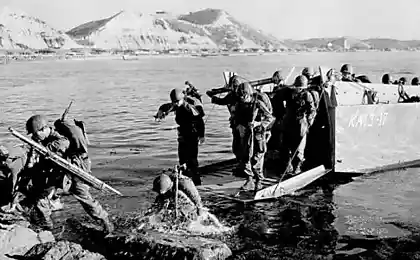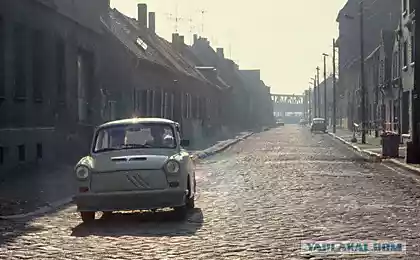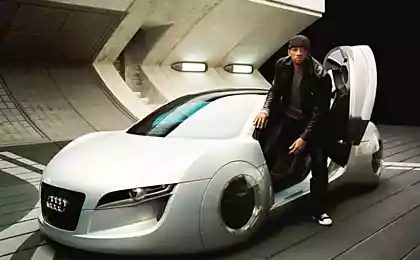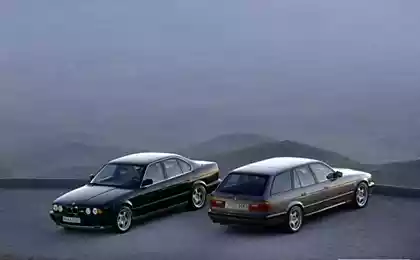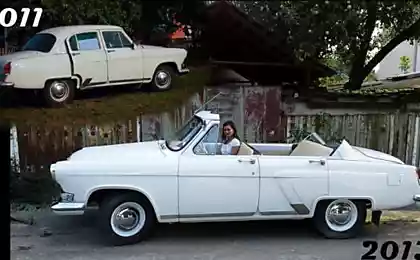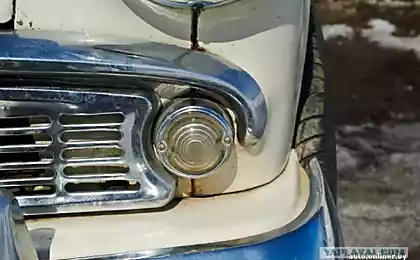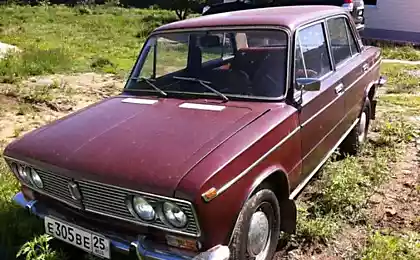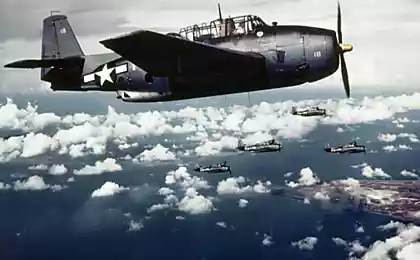972
US minicar.
I went there a conversation about the topic - give, I think, will share.
It will be about twenty pictures with letters, do not break too. Dobyu - will tell.
Then, without edits, the text as it is ...
Here in ICQ comrade quotes: "Famous in 30-50s years of the American manufacturer of minicars Crosley", and asks, and who do this for the Crosley and what is "American minicar." That's the thought that you can be a little obzorchik by three, so to speak, the main mikromonstram - Crosley, Bantam King Midget do so, well, little thing like them, too, not to forget, because in the US, where the V8 familiar with 20- ies, manufacturers minicars are rare and unusual. And I remember gizmo, past which could not pass. And Crosley, and other Midzhet will also, but later. And now in the arena, so to speak, the essence of a simple low-cost car people. In 1910, the UK became available ustroytvo called 'Wall motor wheel', designed to be mounted on bicycles and is a odnotsilinrovy odnosilny motor block with the wheel, fuel tank, and everything else necessary. In the US since 1914 under license proizyodila company 'A. O. Smith Company 'under the name' Smith motor wheel ', and in 1917 they came up with the bright idea to equip this car. And yet, yes, we did. In the photo - Smith Flyer, later, with the change of manufacturer - Briggs & Stratton Flyer. Boardwalk cart on four wheels of the buggy, the two-seat scoop plywood simplest steering - and all. The role played by the suspension of the elastic flexibility of the base board, which can be seen in the photo. And, yes, and behind - the fifth wheel, the wheel is the motor-Smith, a motor with a single-cylinder volume of 160 cubic centimeters and with a capacity of one and a half horsepower, which, however, was enough to disperse the carriage right up to 40 km / h. To start the engine had to be a fifth wheel to lift off the ground, to stop, too, and thus also the brake pedal is pressed against the rear tires of brake pads, placed just inside the flexible rear wings ...

And such a view overlooks the fifth wheel:
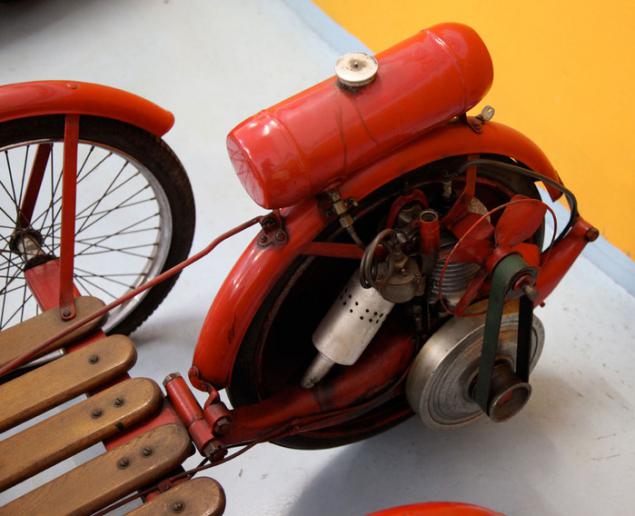
On the Relativity of the concept of "mass cheap car" on the different continents. That is to say, instead of the foreword to the Bantam and Krosleyam. Just for example - a pair of very specific members of one, so to speak, of social class in Europe and the United States of the late 20's - early 30-ies.
British Morris Cowley sample 1926-32 years - four-cylinder, six-liter and 26 forces the brake only to the rear wheels and two hundred thousand copies in 6 years.
French Citrioen C4 1929-33 - the same 4 cylinder, 1.6 liter and 30 strength, 240 thousand.
Examples are many and they are all similar in performance characteristics. A couple of Americans:
Chevrolet AC Six - row of Six to 3.2 liters and power of 50, and by 1934 th - already 80, 800, 000 vehicles sold in the first year of production.
Ford Model A 1927-31 years, the four 3.3-liter and 40 Forces, and almost five million vehicles and, finally, Ford B Model 18 specimen in 1932 - the world's first mass car with the engine V8, 3.6 liter and 65 at first, and then 85 forces, and, again, more than 4 million units of the first series in three years.
This I mean that, for example, subcompact Austin Seven, with its 15-horsepower 747 cc a motor on the background of the middle class looked a little car, but his transatlantic licensed copy of which soon will be discussed against the background of the same Ford V8 look rather comical.
Ford V8:

Before you finally go to Bantam and the other, a few lines of their British ancestors. By 1920, the ninth year after the First World War, more niche-less motor-tools available occupied mainly the so-called cyclecar'y, in fact, four-wheel motorcycles rather than cars. For them it was characterized by an arrangement of two tandem riders, a motorcycle-type steering wheel, no reverse gear, often - one wheel drive, eliminating the need for differential and simple body, and often the lack of it. In the UK, similar structures were often at the same time more and tricycle that allows you to pay tax as a motorcycle. Firms producing such equipment, there were more than a dozen on the photo - a typical and one of the most famous examples - French Bédélia BD2 1913 a liter desyatisilnym motorcycle V2.
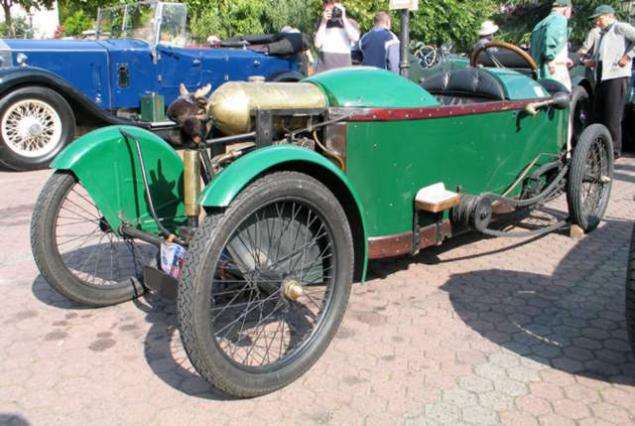
In the early 1920s, the founder and one of the leaders had just nearly bankrupt car company Austin Motor Company Sir Herbert Austin persuaded the board of directors in the prospects compact car and investing their own money in the development, together with the young engineer Stanley Edzhem created design, now known, as the Austin 7. Launched in 1922, Seven, though not particularly for TTX from the same tsiklokarov, however, was very small though, but "real" car, with an engine of 10 horsepower and 747 cm3 volume , but the four-cylinder four-stroke and, united with the three-stage gearbox, moreover, with the exception of the earliest examples, the car equipped with an electric starter and brakes on four wheels that occurred in those years, not every car a class above. Car three meters in length weighing about 360 kg, and accelerated to 80 km / h depending on the version. Total from 1922 to 1939 was made more than 290, 000 vehicles.
In the photo open Austin Quadruple 7 AD Tourer 1928.
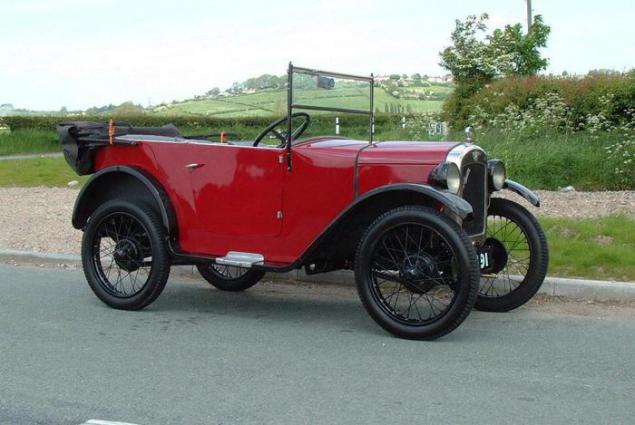
This Austin 7 'Ruby' in 1936.

The first car BMW - 1927 BMW Dixi DA1, licensed copy of the Austin 7. In addition, in France under license produced forgotten now, but then known Rosengart, and in Japan without licenses Nissan.
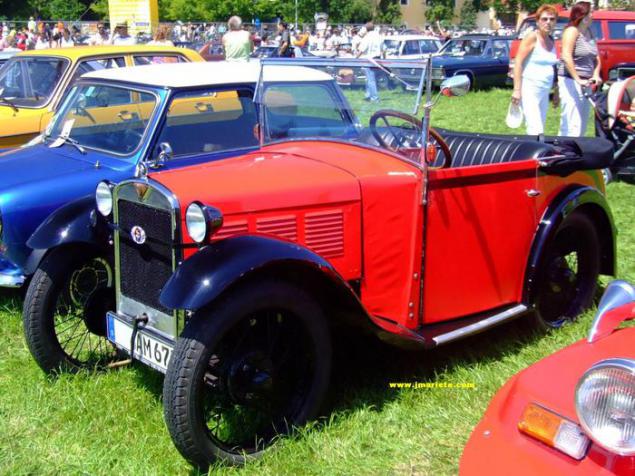
And now, amid Seven'a popularity in Europe, came to someone's head in bright idea to make and sell them in the United States, nemotrya some ... uh ... the difference in the specific markets.
Issued founded in 1929, now American Austin Car Company cars are technically repeated British prototype looks the same, taking into account the local circumstances, were more expressive. The author of the new image was the famous industrial designer of Russian descent, Alexis de Sakhnovskaya who apply avtomobilchiki in the spirit to oryadok more expensive and prestigious Cadillac and Marmon. However, if in the first year proizvodmstva and managed to sell about eight thousand American Austin, by 1932 production was stopped due to unprofitability and lack of demand. A few more cars were collected in 1935-36, the total number was about twenty thousand. Suddenly it turned out that just 10% more expensive than you could not buy a tiny little car, as already mentioned here Chevrolet Six or Ford V8, which, at the then price of gasoline was more than justified. And with the onset of the Great Depression and even plummeted prices in the secondary car market, making American Austin stunt almost meaningless ...
In the picture sample of 1929, apparently still virtually indistinguishable from the British machines.
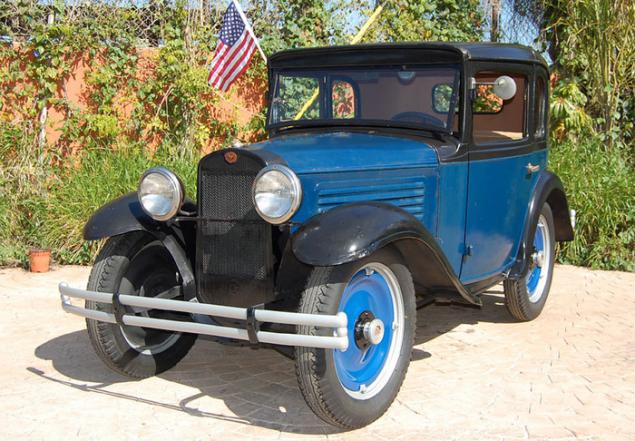
Roadster sample of 1932 working de Sakhnovskaya.
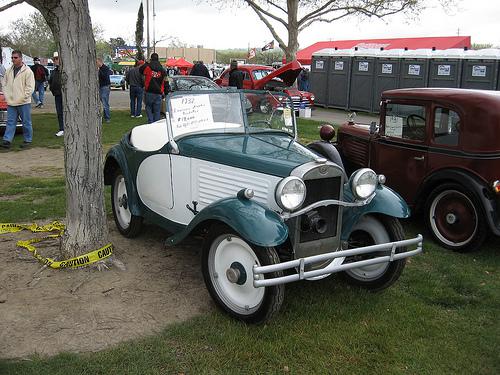
Wonderful photo on background not seem very large Eldorado, '67 ...
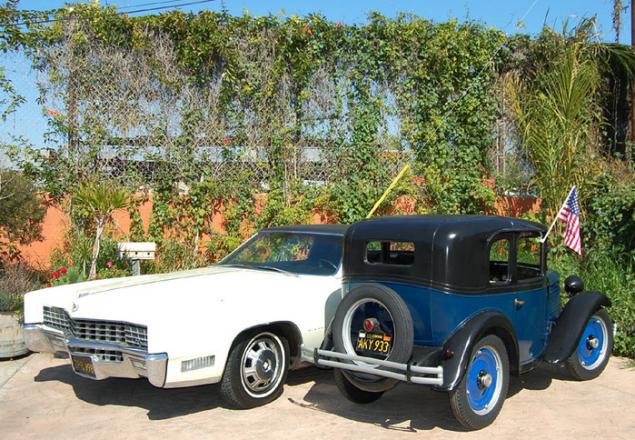
And yet there are those craters where the projectile falls twice.
In 1935, a former dealer Austin Roy Evans has hired the creator of the famous racing cars of Harry Miller and all the same de Sakhnovskaya bought bankrupt company American Austin in 1936 and resumed production of processed fairly, but do not add to the size of the car. All the same 747 cc engine now develops 20 horsepower, the speed increased to 100 km / h, offers a wide range of bodies of modern species, such as the Roadster 1937:
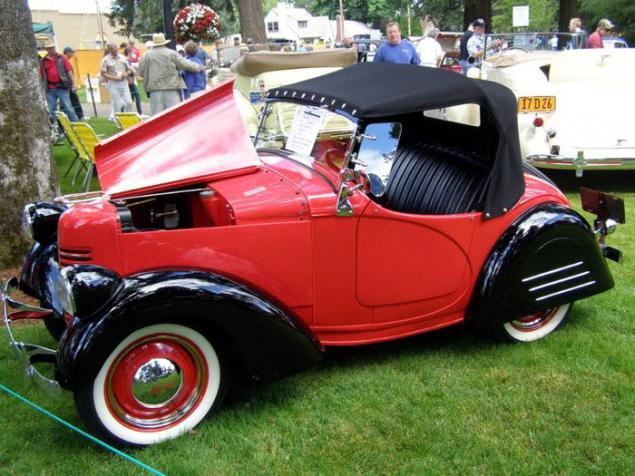
... And here is such a delivery van Boulevard Delivery Van 1939.
Cars 1940 model year received increased to 815 blocks in 22 motor power, but in 1941 the production was finally discontinued. In total since 1936 to 41 th year was released about six thousand Bantam - a drop in the sea in the background Every year millions of Ford or GM.
On the role of the firm Bantam in the creation of SUVs I've written, and after the release of the party-wheel drive cars the company switched to production of single-axle trailers, first to the jeep, and then, after the war, and for passenger cars, and this takes up the absorption of it by someone in 1956 ...
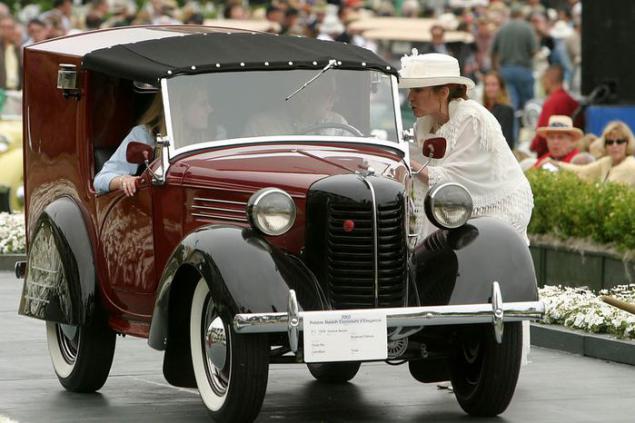
Hobbies tycoons ...
Unlike most avtopromyshlennikom Powell Crosley (Powell Crosley, 1886-1961), who built his first car at the beginning of the century, in 1939 he possessed a sustainable business for the production of radio equipment from Radio to private radio stations, industrial refrigerators and many other things and was a man, to say the least secure. Production of the car was a dream brought to life through capital Crosley never really bother with the profitability of the industry of its activities. The dream was not just the production of cars and car production public.
The first cars appeared at Crosley brand dealers in 1939 and was not an example of modest, even the same Bantam, with, however, one and a half times lower price. Despite the statement in the catalog diversity, live model Crosley C1A sample in 1939 was offered with only two open bodies. They are equipped with a two-cylinder boxer engine air cooling Waukesha (0.6l, 12l.s.), 12-inch wheels, single speedometer on the dashboard, and a whole bunch of childhood diseases ...

Very informative promotional material Crosley for 1941, and then a variety of bodies, and information on the run across the US, and price.
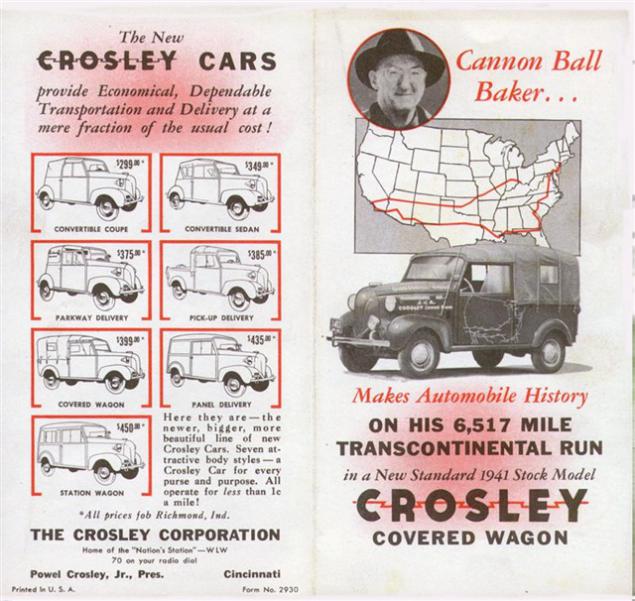
By 1941, the ninth year have improved the car thoroughly cured of most structural defects. The engine of the same capacity, but reduced the volume is no longer broke vibration mount and front fenders, the gearbox is no longer crumble blows the propeller shaft at running back wheel on an obstacle, well, and so on. Things even went to the mountain, but to the middle of 1942, all US car industry finally moved to the production of military products exclusively. Crosley has remained one of the last manufacturers of civilian cars because of their efficiency in terms of fuel economy, because the claimed fuel consumption of only four liters per hundred, in practice, however, the average was closer to five more liters, yet. Total up to mid-1942 Powell Crosley managed to sell a little more than five thousand cars, which were implemented in particular in conventional supermarkets along with car dealers. In a rare photo CB42 Liberty Sedan of the latter.
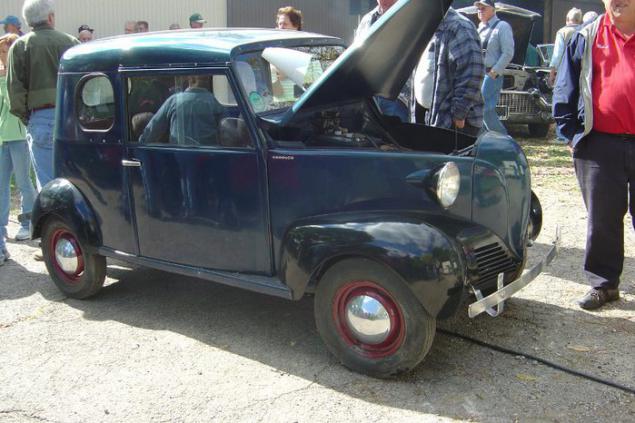
Although Crosley and released for a number of purposes yoennyh patrol avtomobilchikov D1, its main products in wartime become small engines and portable generators on their basis. Engine Crosley CoBra (Copper Brazed) - a unique thing, developed by Taylor Engines. Instead of the traditional casting a cylinder block was made by welding of stamped sheet steel parts, followed by quenching. As a result, the engine turned unusually light - with volume of 720 cm3 four-cylinder engine develops 36 hp at 5600 rpm and weighed with only 60kg, of which the welding unit had only 6.5, while in the engine endurance tests showed himself very well, having worked 1,200 hours without a break. Of course, after the war, resuming car production, Crosley decided to apply this nicknamed "Mighty tin" unit and on this front. As it turned out, in vain ...

May 9, 1946 were the first postwar Crosley, a few grown in size and equipped with power derated to 26 for regular gasoline engines CoBra. The rest of constructive machines have not changed much, in spite of an entirely new body. However, soon - again, all of a sudden - it turned out that works great for constant speed and with a well-established temperature conditions paired with a generator, the motor is somewhat less suitable for use in the modes of variables speed and the temperature, in addition, in the car it is much more exposed to moisture and being made of steel and copper, had a tendency to rapid galvanic corrosion, coming a year or two in complete disrepair. However, if in 1946 made about 5, 000 machines, in 1947 more than 19, 000, and in the 48th - nearly 29, 000. In 1949, planned to sell 80 thousand, but by this time recovered from the war and the enterprise Big Three, and sales fell to seven and a half thousand ...
In 1949 the new engine was introduced a more traditional design with a cast iron block, it must be said that at the same power he was seriously only a few kilograms. However, demand fell rapidly, and in 1952 production was discontinued. Himself Powell Crosley this little innocent hobby at a cost of three million of the then, what, however, he was not sorry.
Universalchik Crosley CC 1947 or '48 ...

However, before closing Crosley distinguished by the fact that in the United States released the first post-war sports car and the first car in the US, standard equipped with disc brakes on all wheels. It was Hotshot Roadster and Super Sports development sample 1949-52's, made a few hundred copies.

Pikapchik Crosley Farm-O-Road
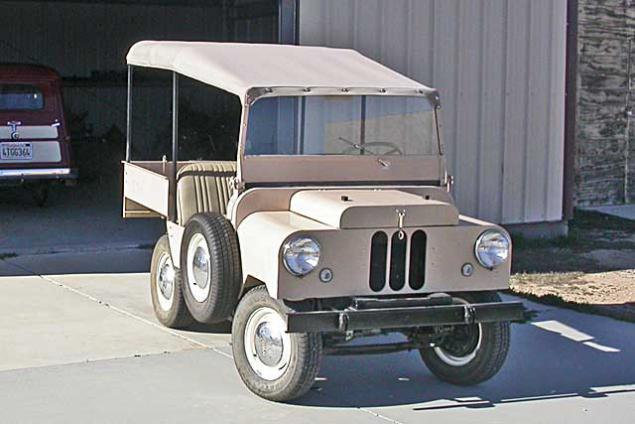
Asked to finish the topic. I have that, I do not mind ...
Still remember how it was decided, looking at the "Zaporozhets", for example, confidently say that - well, at only in the Soviet Union is to build can, and here in America, something or Europe is in a dream terrible not dream, there is only Cadillacs and Mercedes. And somehow overlooked and mass sidecars à la Messerschmitt Kabineroller or Izetta in the same Germany, where "all the Mercedes," and, for example, BMW 700, next to which the same ZAZ-966 is not something to a masterpiece of engineering - but it is currently. Not to mention the other states Goggomobilyah Lloyd, small Fiat and Citroen De shvo and other. Well, and if it came across his arm microcar disability, 3M - especially flows sarcasm no obstacles ... About Crosley everything is revered, move on to more smaller forms.
Two American pilot, Claud Dry and Dale Orcutt, met during the war, planned to create a simple and popular car. In principle, the idea of Crosley was similar, but the two have gone much further. Introduced in 1946, the 'King Midget' model 1 was sold as a kit car (set for self-construction) and is a vehicle extremely uncomplicated. The set value of $ 50 were wooden frame bridges with suspension and steering, a set of patterns for the independent production of single body made of sheet metal and assembly guide. It was assumed that the appropriate single-cylinder engine uses the owner of the decommissioned motor vehicles or acquire separately. Later in sale and assembled cars shestisilnym a motor. The engine was located in the back of stylized racing cars 20-ies of the body, and especially courageous owners broke up this miracle right up to 80 km / h. Complete car costs about $ 350.
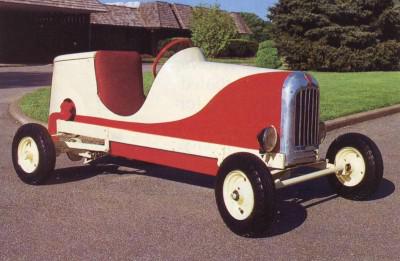
... It looks like that. In total since 1946 to 51 years, has sold nearly five hundred copies, however, different sources give different figures and more.
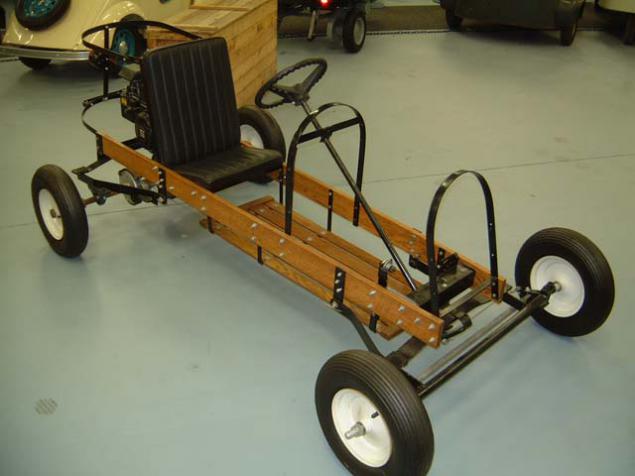
Established in 1951, King Midget II was already a two-seater, while the rest retained much from its predecessor. Rama was the steel, suspension spring, but remained and the brakes on the rear wheels only, mechanical cable-operated, and "starter" as a starter cord otsutvie backing and any devices. However, this is true only for the basic version - for some money offered and elektrostartёr and speedometer, and even the original automatic transmission with reverse gear, however, still with a drive on one rear wheel ... In addition, the purchase could awning and hinged doors , heater and much more. Practical Capacity exceeded avtomobilchika own weight, is slightly more than 250kg. In the years 1951-57 was made, according to various estimates, the second series of 1100-1600 cars, interestingly, wheels and mufflers are available from Crosley ...

... And most advanced - the third, produce from 1957 to 1970. It has automatic transmission and elektrostartёr in the database, as well as hydraulic brakes and doors and awning. Also single cylinder engines, and about 350 cm3 capacity the years between 9 and 12 force. Production ceased in 1970 due to the inability to enter into the construction of the new standards of passive safety and emissions control, and is currently preserved about 750 machines of the third series of about three and a half thousand issued. And you say - Zaporozhets ...

Last.
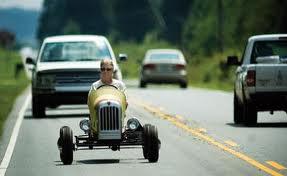
Source:
It will be about twenty pictures with letters, do not break too. Dobyu - will tell.
Then, without edits, the text as it is ...
Here in ICQ comrade quotes: "Famous in 30-50s years of the American manufacturer of minicars Crosley", and asks, and who do this for the Crosley and what is "American minicar." That's the thought that you can be a little obzorchik by three, so to speak, the main mikromonstram - Crosley, Bantam King Midget do so, well, little thing like them, too, not to forget, because in the US, where the V8 familiar with 20- ies, manufacturers minicars are rare and unusual. And I remember gizmo, past which could not pass. And Crosley, and other Midzhet will also, but later. And now in the arena, so to speak, the essence of a simple low-cost car people. In 1910, the UK became available ustroytvo called 'Wall motor wheel', designed to be mounted on bicycles and is a odnotsilinrovy odnosilny motor block with the wheel, fuel tank, and everything else necessary. In the US since 1914 under license proizyodila company 'A. O. Smith Company 'under the name' Smith motor wheel ', and in 1917 they came up with the bright idea to equip this car. And yet, yes, we did. In the photo - Smith Flyer, later, with the change of manufacturer - Briggs & Stratton Flyer. Boardwalk cart on four wheels of the buggy, the two-seat scoop plywood simplest steering - and all. The role played by the suspension of the elastic flexibility of the base board, which can be seen in the photo. And, yes, and behind - the fifth wheel, the wheel is the motor-Smith, a motor with a single-cylinder volume of 160 cubic centimeters and with a capacity of one and a half horsepower, which, however, was enough to disperse the carriage right up to 40 km / h. To start the engine had to be a fifth wheel to lift off the ground, to stop, too, and thus also the brake pedal is pressed against the rear tires of brake pads, placed just inside the flexible rear wings ...

And such a view overlooks the fifth wheel:

On the Relativity of the concept of "mass cheap car" on the different continents. That is to say, instead of the foreword to the Bantam and Krosleyam. Just for example - a pair of very specific members of one, so to speak, of social class in Europe and the United States of the late 20's - early 30-ies.
British Morris Cowley sample 1926-32 years - four-cylinder, six-liter and 26 forces the brake only to the rear wheels and two hundred thousand copies in 6 years.
French Citrioen C4 1929-33 - the same 4 cylinder, 1.6 liter and 30 strength, 240 thousand.
Examples are many and they are all similar in performance characteristics. A couple of Americans:
Chevrolet AC Six - row of Six to 3.2 liters and power of 50, and by 1934 th - already 80, 800, 000 vehicles sold in the first year of production.
Ford Model A 1927-31 years, the four 3.3-liter and 40 Forces, and almost five million vehicles and, finally, Ford B Model 18 specimen in 1932 - the world's first mass car with the engine V8, 3.6 liter and 65 at first, and then 85 forces, and, again, more than 4 million units of the first series in three years.
This I mean that, for example, subcompact Austin Seven, with its 15-horsepower 747 cc a motor on the background of the middle class looked a little car, but his transatlantic licensed copy of which soon will be discussed against the background of the same Ford V8 look rather comical.
Ford V8:

Before you finally go to Bantam and the other, a few lines of their British ancestors. By 1920, the ninth year after the First World War, more niche-less motor-tools available occupied mainly the so-called cyclecar'y, in fact, four-wheel motorcycles rather than cars. For them it was characterized by an arrangement of two tandem riders, a motorcycle-type steering wheel, no reverse gear, often - one wheel drive, eliminating the need for differential and simple body, and often the lack of it. In the UK, similar structures were often at the same time more and tricycle that allows you to pay tax as a motorcycle. Firms producing such equipment, there were more than a dozen on the photo - a typical and one of the most famous examples - French Bédélia BD2 1913 a liter desyatisilnym motorcycle V2.

In the early 1920s, the founder and one of the leaders had just nearly bankrupt car company Austin Motor Company Sir Herbert Austin persuaded the board of directors in the prospects compact car and investing their own money in the development, together with the young engineer Stanley Edzhem created design, now known, as the Austin 7. Launched in 1922, Seven, though not particularly for TTX from the same tsiklokarov, however, was very small though, but "real" car, with an engine of 10 horsepower and 747 cm3 volume , but the four-cylinder four-stroke and, united with the three-stage gearbox, moreover, with the exception of the earliest examples, the car equipped with an electric starter and brakes on four wheels that occurred in those years, not every car a class above. Car three meters in length weighing about 360 kg, and accelerated to 80 km / h depending on the version. Total from 1922 to 1939 was made more than 290, 000 vehicles.
In the photo open Austin Quadruple 7 AD Tourer 1928.

This Austin 7 'Ruby' in 1936.

The first car BMW - 1927 BMW Dixi DA1, licensed copy of the Austin 7. In addition, in France under license produced forgotten now, but then known Rosengart, and in Japan without licenses Nissan.

And now, amid Seven'a popularity in Europe, came to someone's head in bright idea to make and sell them in the United States, nemotrya some ... uh ... the difference in the specific markets.
Issued founded in 1929, now American Austin Car Company cars are technically repeated British prototype looks the same, taking into account the local circumstances, were more expressive. The author of the new image was the famous industrial designer of Russian descent, Alexis de Sakhnovskaya who apply avtomobilchiki in the spirit to oryadok more expensive and prestigious Cadillac and Marmon. However, if in the first year proizvodmstva and managed to sell about eight thousand American Austin, by 1932 production was stopped due to unprofitability and lack of demand. A few more cars were collected in 1935-36, the total number was about twenty thousand. Suddenly it turned out that just 10% more expensive than you could not buy a tiny little car, as already mentioned here Chevrolet Six or Ford V8, which, at the then price of gasoline was more than justified. And with the onset of the Great Depression and even plummeted prices in the secondary car market, making American Austin stunt almost meaningless ...
In the picture sample of 1929, apparently still virtually indistinguishable from the British machines.

Roadster sample of 1932 working de Sakhnovskaya.

Wonderful photo on background not seem very large Eldorado, '67 ...

And yet there are those craters where the projectile falls twice.
In 1935, a former dealer Austin Roy Evans has hired the creator of the famous racing cars of Harry Miller and all the same de Sakhnovskaya bought bankrupt company American Austin in 1936 and resumed production of processed fairly, but do not add to the size of the car. All the same 747 cc engine now develops 20 horsepower, the speed increased to 100 km / h, offers a wide range of bodies of modern species, such as the Roadster 1937:

... And here is such a delivery van Boulevard Delivery Van 1939.
Cars 1940 model year received increased to 815 blocks in 22 motor power, but in 1941 the production was finally discontinued. In total since 1936 to 41 th year was released about six thousand Bantam - a drop in the sea in the background Every year millions of Ford or GM.
On the role of the firm Bantam in the creation of SUVs I've written, and after the release of the party-wheel drive cars the company switched to production of single-axle trailers, first to the jeep, and then, after the war, and for passenger cars, and this takes up the absorption of it by someone in 1956 ...

Hobbies tycoons ...
Unlike most avtopromyshlennikom Powell Crosley (Powell Crosley, 1886-1961), who built his first car at the beginning of the century, in 1939 he possessed a sustainable business for the production of radio equipment from Radio to private radio stations, industrial refrigerators and many other things and was a man, to say the least secure. Production of the car was a dream brought to life through capital Crosley never really bother with the profitability of the industry of its activities. The dream was not just the production of cars and car production public.
The first cars appeared at Crosley brand dealers in 1939 and was not an example of modest, even the same Bantam, with, however, one and a half times lower price. Despite the statement in the catalog diversity, live model Crosley C1A sample in 1939 was offered with only two open bodies. They are equipped with a two-cylinder boxer engine air cooling Waukesha (0.6l, 12l.s.), 12-inch wheels, single speedometer on the dashboard, and a whole bunch of childhood diseases ...

Very informative promotional material Crosley for 1941, and then a variety of bodies, and information on the run across the US, and price.

By 1941, the ninth year have improved the car thoroughly cured of most structural defects. The engine of the same capacity, but reduced the volume is no longer broke vibration mount and front fenders, the gearbox is no longer crumble blows the propeller shaft at running back wheel on an obstacle, well, and so on. Things even went to the mountain, but to the middle of 1942, all US car industry finally moved to the production of military products exclusively. Crosley has remained one of the last manufacturers of civilian cars because of their efficiency in terms of fuel economy, because the claimed fuel consumption of only four liters per hundred, in practice, however, the average was closer to five more liters, yet. Total up to mid-1942 Powell Crosley managed to sell a little more than five thousand cars, which were implemented in particular in conventional supermarkets along with car dealers. In a rare photo CB42 Liberty Sedan of the latter.

Although Crosley and released for a number of purposes yoennyh patrol avtomobilchikov D1, its main products in wartime become small engines and portable generators on their basis. Engine Crosley CoBra (Copper Brazed) - a unique thing, developed by Taylor Engines. Instead of the traditional casting a cylinder block was made by welding of stamped sheet steel parts, followed by quenching. As a result, the engine turned unusually light - with volume of 720 cm3 four-cylinder engine develops 36 hp at 5600 rpm and weighed with only 60kg, of which the welding unit had only 6.5, while in the engine endurance tests showed himself very well, having worked 1,200 hours without a break. Of course, after the war, resuming car production, Crosley decided to apply this nicknamed "Mighty tin" unit and on this front. As it turned out, in vain ...

May 9, 1946 were the first postwar Crosley, a few grown in size and equipped with power derated to 26 for regular gasoline engines CoBra. The rest of constructive machines have not changed much, in spite of an entirely new body. However, soon - again, all of a sudden - it turned out that works great for constant speed and with a well-established temperature conditions paired with a generator, the motor is somewhat less suitable for use in the modes of variables speed and the temperature, in addition, in the car it is much more exposed to moisture and being made of steel and copper, had a tendency to rapid galvanic corrosion, coming a year or two in complete disrepair. However, if in 1946 made about 5, 000 machines, in 1947 more than 19, 000, and in the 48th - nearly 29, 000. In 1949, planned to sell 80 thousand, but by this time recovered from the war and the enterprise Big Three, and sales fell to seven and a half thousand ...
In 1949 the new engine was introduced a more traditional design with a cast iron block, it must be said that at the same power he was seriously only a few kilograms. However, demand fell rapidly, and in 1952 production was discontinued. Himself Powell Crosley this little innocent hobby at a cost of three million of the then, what, however, he was not sorry.
Universalchik Crosley CC 1947 or '48 ...

However, before closing Crosley distinguished by the fact that in the United States released the first post-war sports car and the first car in the US, standard equipped with disc brakes on all wheels. It was Hotshot Roadster and Super Sports development sample 1949-52's, made a few hundred copies.

Pikapchik Crosley Farm-O-Road

Asked to finish the topic. I have that, I do not mind ...
Still remember how it was decided, looking at the "Zaporozhets", for example, confidently say that - well, at only in the Soviet Union is to build can, and here in America, something or Europe is in a dream terrible not dream, there is only Cadillacs and Mercedes. And somehow overlooked and mass sidecars à la Messerschmitt Kabineroller or Izetta in the same Germany, where "all the Mercedes," and, for example, BMW 700, next to which the same ZAZ-966 is not something to a masterpiece of engineering - but it is currently. Not to mention the other states Goggomobilyah Lloyd, small Fiat and Citroen De shvo and other. Well, and if it came across his arm microcar disability, 3M - especially flows sarcasm no obstacles ... About Crosley everything is revered, move on to more smaller forms.
Two American pilot, Claud Dry and Dale Orcutt, met during the war, planned to create a simple and popular car. In principle, the idea of Crosley was similar, but the two have gone much further. Introduced in 1946, the 'King Midget' model 1 was sold as a kit car (set for self-construction) and is a vehicle extremely uncomplicated. The set value of $ 50 were wooden frame bridges with suspension and steering, a set of patterns for the independent production of single body made of sheet metal and assembly guide. It was assumed that the appropriate single-cylinder engine uses the owner of the decommissioned motor vehicles or acquire separately. Later in sale and assembled cars shestisilnym a motor. The engine was located in the back of stylized racing cars 20-ies of the body, and especially courageous owners broke up this miracle right up to 80 km / h. Complete car costs about $ 350.

... It looks like that. In total since 1946 to 51 years, has sold nearly five hundred copies, however, different sources give different figures and more.

Established in 1951, King Midget II was already a two-seater, while the rest retained much from its predecessor. Rama was the steel, suspension spring, but remained and the brakes on the rear wheels only, mechanical cable-operated, and "starter" as a starter cord otsutvie backing and any devices. However, this is true only for the basic version - for some money offered and elektrostartёr and speedometer, and even the original automatic transmission with reverse gear, however, still with a drive on one rear wheel ... In addition, the purchase could awning and hinged doors , heater and much more. Practical Capacity exceeded avtomobilchika own weight, is slightly more than 250kg. In the years 1951-57 was made, according to various estimates, the second series of 1100-1600 cars, interestingly, wheels and mufflers are available from Crosley ...

... And most advanced - the third, produce from 1957 to 1970. It has automatic transmission and elektrostartёr in the database, as well as hydraulic brakes and doors and awning. Also single cylinder engines, and about 350 cm3 capacity the years between 9 and 12 force. Production ceased in 1970 due to the inability to enter into the construction of the new standards of passive safety and emissions control, and is currently preserved about 750 machines of the third series of about three and a half thousand issued. And you say - Zaporozhets ...

Last.

Source:

